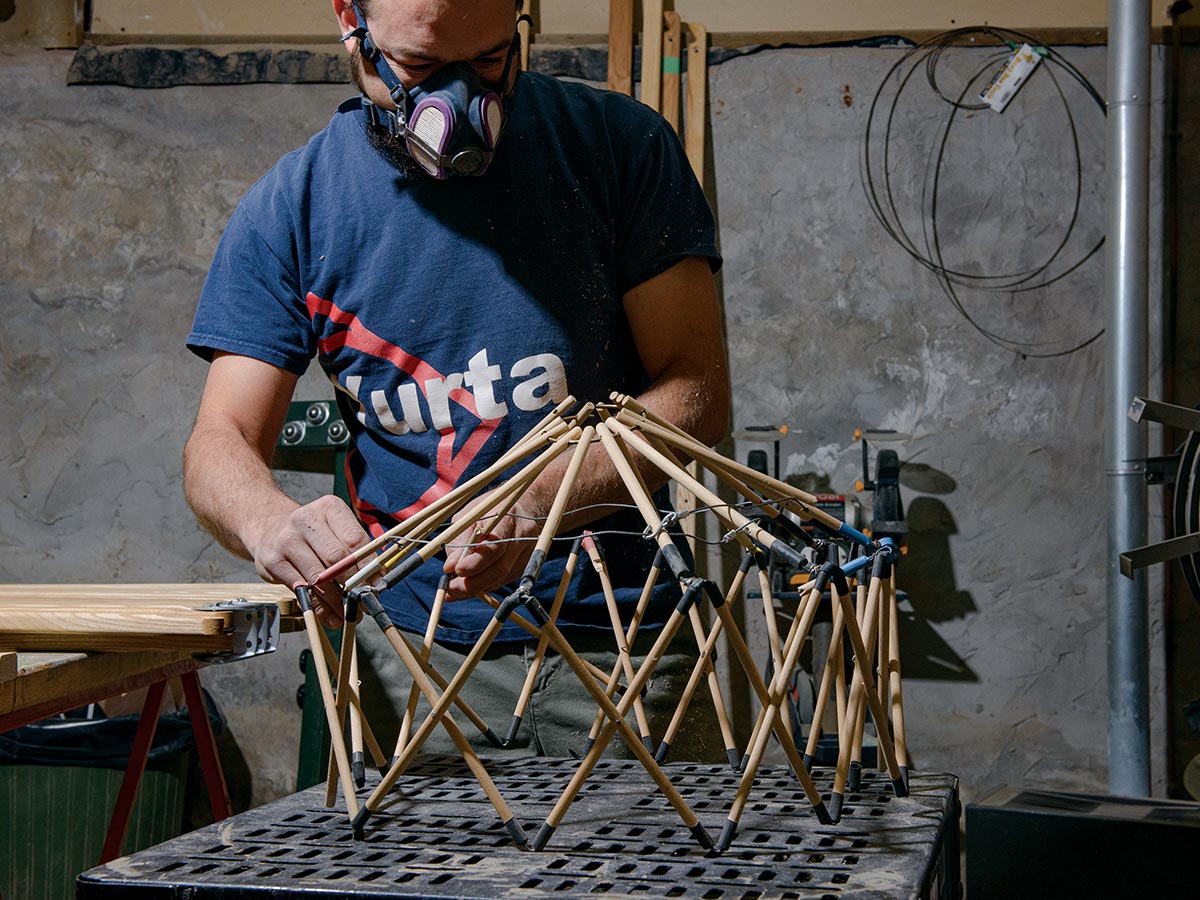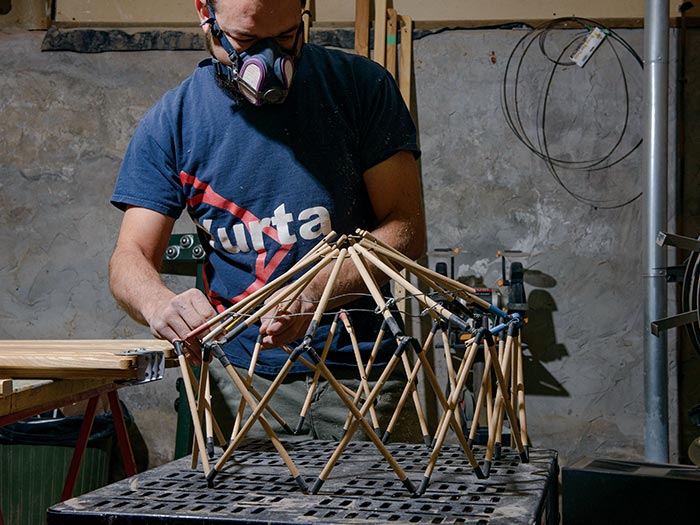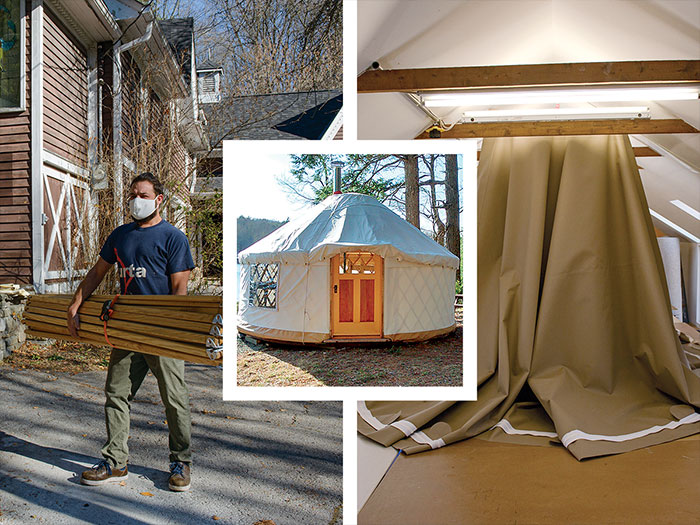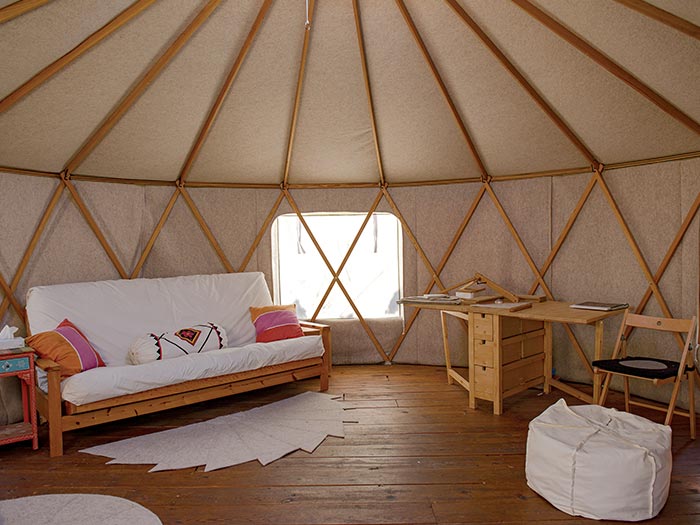
Are yurts the next big thing in portable housing?
 Yurta’s Patrick Ladisa using a model to demonstrate a yurt’s contractible trellis (Photograph by Daniel Neuhaus)
Yurta’s Patrick Ladisa using a model to demonstrate a yurt’s contractible trellis (Photograph by Daniel Neuhaus)
Thanks in part to an active community of Canadian builders, the yurt has successfully migrated west, where the tent-like structure has grown in popularity in recent years; yurts have become the unofficial face of “glamping” in Canada. Parks Canada offers yurts for overnight stays at places like Kejimkujik National Park in Nova Scotia, Riding Mountain National Park in Manitoba, and New Brunswick’s Fundy National Park, where there are five yurt locations to stay in.
But with the COVID-19 pandemic taking hold, yurts have reached a whole new market of social-distancers looking for extra space. For Canadian yurt manufacturers, like Little Foot Yurts of Wolfville, N.S., and Pickering, Ont.-based Yurta, the demand has risen exponentially. With people encouraged to distance indoors, these lightweight pop-up shelters have become a viable solution for those wanting to invite visitors to stay on their property, while minimizing the spread of airborne virus.
“We’ve encountered a lot of people who own a cottage and live in the city and want to take advantage of the opportunity to get out of the city—but they want to share that experience with friends and family,” says Alex Cole, who co-founded Little Foot with his wife, Selene. “What they really need is a yurt.”
 Yurta’s Ladisa transporting lumber at his company’s Pickering, Ont. workshop; Little Foot Yurts built this unit available for rent in Nova Scotia’s Kejimkujik National Park; A canvas rooftop being sewn at Yurta’s workshop (Yurt images courtesy Little Foot Yurts; image of Ladisa by Daniel Neuhaus)
Yurta’s Ladisa transporting lumber at his company’s Pickering, Ont. workshop; Little Foot Yurts built this unit available for rent in Nova Scotia’s Kejimkujik National Park; A canvas rooftop being sewn at Yurta’s workshop (Yurt images courtesy Little Foot Yurts; image of Ladisa by Daniel Neuhaus)
Cole says that since the pandemic began he’s gone from receiving a handful of inquiries to dozens each month. It’s not hard to understand why. Beyond their small ecological footprint, yurts are a lower-cost alternative to a standard outbuilding and, because they are not a fixed structure, there is often no need for construction permits (plumbing and electrical excepted). They can be winterized and are portable, with some designed to fit on the roof of a car after disassembly—most yurts are built with detachable wooden flooring, a canvas or vinyl tent covering and a wooden trellis frame that collapses like a baby gate.
“Our bread and butter has been cottage and landowners who want a small bunkie on their property,” says Patrick Ladisa, president of Yurta. His phone has also been ringing more than ever and, amid the pandemic, has seen his client base expand to include commercial clients and hospitals looking to create additional space for nurses and other staff.
Even restaurants are embracing yurts, like Toronto’s Amsterdam brew pub, which purchased an $11,000 yurt that can hold up to six diners. General manager Matt Peacock has called his yurt “a lifeline” during winter months when patios aren’t as attractive.
 Finished interior of decked-out yurt (Photograph by Daniel Neuhaus)
Finished interior of decked-out yurt (Photograph by Daniel Neuhaus)
Canadian-built yurts start at roughly $9,000 and, depending on the size and amenities, go up in price from there. Some feature fireplaces, patios and even indoor swimming pools. In many cases, the buyer doubles as the builder, with detailed plans provided and, in the case of Little Foot, even workshops offered by the manufacturers.
When Yurta first opened shop in 2004, its first client was what Ladisa calls a “harbinger of the Airbnb’ers.” Four years before the popular property rental company existed, Yurta’s first two sales were for structures purchased as guest houses available for rent.
Yurta’s Ladisa won’t go so far as to call yurts “mainstream” quite yet, “but there’s no question they’re entering the public consciousness more than ever.”
“[The pandemic] has really pushed a lot of people to say, ‘I want to get back to nature,’” he says. “There’s no question we’re seeing that rural-urban shift reflected in our business.”
LOOKING AHEAD
The pandemic has already affected the way we live, work and move. We asked the experts how they are reimaging the future.